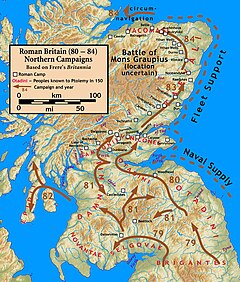Battle of Mons Graupius
| Battle of Mons Graupius | |||||||
|---|---|---|---|---|---|---|---|
| Part of Roman conquest of Britain | |||||||
 | |||||||
| |||||||
| Belligerents | |||||||
| Roman Empire |
Caledonian Confederacy | ||||||
| Commanders and leaders | |||||||
| Agricola | Calgacus | ||||||
| Strength | |||||||
| 17,000-30,000+ | 15,000-30,000+ | ||||||
| Casualties and losses | |||||||
| 360 dead | 10,000 dead | ||||||
The Battle of Mons Graupius was, according to
Background
Even though the Romans were outnumbered in their campaign against the tribes of
Location
The Battle of Mons Graupius has been a constant motif in the study of
Considerable debate and analysis have been conducted regarding the battle location, with the locus of most of these sites spanning
Those sites in Aberdeenshire fit the historical descriptions of Tacitus and have also yielded
Historic Environment Scotland noted the uncertainty of the location as the reason for its exclusion from the Inventory of Historic Battlefields in Scotland.[14]
Battle
According to Tacitus, 8,000
After a brief exchange of missiles, Agricola ordered auxiliaries to launch a frontal attack on the enemy. These were based around four cohorts of
It is said that the Roman Legions took no part in the battle, being held in reserve throughout. According to Tacitus, 10,000 Caledonian people died at a cost of only 360 auxiliary troops. 20,000 Caledonians retreated into the woods, where they fared considerably better against pursuing forces. Roman scouts were unable to locate the remaining Caledonian forces the next morning.
Criticisms of Tacitus's account
The decisive victory reported by Tacitus has been criticized by some historians, however, who believe no engagement occurred. One author has suggested that the emperor Domitian may have been informed of the fraudulence of Agricola's claims to have won a significant victory.[20][21] Despite these claims, Agricola was awarded triumphal honours and was offered another governorship in a different part of the empire, so it would seem unlikely Domitian doubted he had achieved substantial successes. Suggestions that he invented the entire episode and was thereafter shunned by the emperor do not seem likely, given that he was awarded honours on his return.
Aftermath
Following this final battle, it was proclaimed that Agricola had finally subdued all the tribes of Britain. Soon afterwards he was recalled to Rome, and his post passed to Sallustius Lucullus. It is likely that Rome intended to continue the conflict, but that military requirements elsewhere in the empire necessitated a troop withdrawal and the opportunity was lost.
Tacitus' statement in his account of Roman history between 68 AD and 98 AD: Perdomita Britannia et statim missa (Britain was completely conquered and immediately let go), denotes his bitter disapproval of Domitian's failure to unify the whole island under Roman rule after Agricola's successful campaign.[22]
See also
References
- ISBN 978-0-19-923482-0.
- ^ William Roy, The Military Antiquities of the Romans in Britain, 1793
- ^ Gabriel Jacques Surenne, 1823 Correspondence to Sir Walter Scott
- ^ On the battle's location, see Duncan B. Campbell, "Search for a lost battlefield", Ancient Warfare Vol. 8 issue 1 (2014), pp. 47-51.
- ^ J. Joseph. The Camp at Durno, Aberdeenshire, and the site of Mons Graupius. Britannia, 9, 271-287 (1978); Peter Salway. Roman Britain Oxford: Oxford University Press (1981); Duncan B. Campbell, Mons Graupius AD 83, Oxford: Osprey Publishing, 2010.
- ^ On the battle's location, see Duncan B. Campbell, "Search for a lost battlefield", Ancient Warfare Vol. 8 issue 1 (2014), pp. 47-51.
- ^ William Roy, The Military Antiquities of the Romans in Britain, 1793
- ^ Gabriel Jacques Surenne, 1823 Correspondence to Sir Walter Scott
- ^ Archibald Watt, Highways and byways around Kincardineshire, Stonehaven Heritage Soc., Scotland
- ^ a b C. Michael Hogan, Elsick Mounth, The Megalithic Portal, ed. A. Burnham. [1]
- ^ Duncan B. Campbell, Mons Graupius AD 83, Oxford: Osprey Publishing, 2010.
- ^ Wolfson, Stan (2002) "The Boresti; The Creation of a Myth" Tacitus, Thule and Caledonia. Tiscali.co.uk. Retrieved 21 August 2010.
- ^ "Mons Graupius Identified" romanscotland.org.uk. Retrieved 21 August 2010.
- ^ "Inventory of Historic Battlefields Research Report: Mons Graupius" (PDF). Historic Environment Scotland. 11 July 2016. Retrieved 18 April 2019.
- ^ Duncan B. Campbell, Mons Graupius AD 83, Oxford: Osprey Publishing, 2010
- ISBN 978-0-7486-1736-4 p.204 [2]
- ^ A temporary camp at Durno (20m or 32km NW of Aberdeen) covered 144 acres (60ha) and could have held 24,000 men. Roger J.A. Wilson A Guide to the Roman Remains in Britain 2002 Constable, London
- ISBN 978-0-415-00804-4pp.8, 169
- ISBN 978-0752430447p.217
- ^ Henig, Martin (September 1998) "Togidubnus and the Roman liberation" Archived 11 February 2012 at the Wayback Machine British Archaeology 37. Retrieved 27 July 2008.
- ^ Now refuted by Duncan B. Campbell, Mons Graupius AD 83, Oxford: Osprey Publishing, 2010.
- ISBN 0-7102-1215-1
Further reading
- James E. Fraser, The Roman Conquest Of Scotland: The Battle Of Mons Graupius AD 84
- Duncan B. Campbell, Mons Graupius AD 83, Oxford: Osprey Publishing, 2010.
- A.J. Woodman (with C. Kraus), Tacitus: Agricola, Cambridge: Cambridge University Press, 2014.
- Duncan B. Campbell, 'A note on the Battle of Mons Graupius', Classical Quarterly 65 (2015), pp. 407–410.
